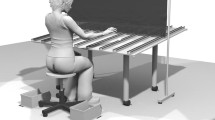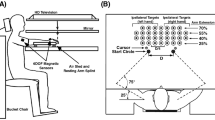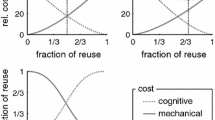Abstract
Previous studies have proposed that selecting which hand to use for a reaching task appears to be modulated by a factor described as “task difficulty,” defined by either the requirement for spatial precision or movement sequences. However, we previously reported that analysis of the movement costs associated with even simple movements plays a major role in hand selection. We further demonstrated, in right-handers, that cognitive-perceptual loading modulates hand selection by interfering with the analysis of such costs. It has been reported that left-handers tend to show less dominant hand bias in selecting which hand to use during reaching. We, therefore, hypothesized that hand selection would be less affected by cognitive-perceptual loading in left-handers than in right-handers. We employed a visual search task that presented different levels of difficulty (cognitive-perceptual load), as established in previous studies. Our findings indicate that left-handed participants tend to show greater modulation of hand selection by cognitive-perceptual loading than right-handers. Left-handers showed lower dominant hand reaction times than right-handers, and greater high-cost movements that reached to extremes of the contralateral workspace under the most difficult task conditions. We previously showed in this task that midline crossing has high-energy and time costs and that they occur more frequently under cognitively demanding conditions. The current study revealed that midline crossing was associated with the lowest reaction times, in both handedness groups. The fact that left-handers showed lower dominant hand reaction times, and a greater number of high-cost cross-midline reaches under the most cognitively demanding conditions suggests that these actions were erroneous.







Similar content being viewed by others
References
Barthélémy S, Boulinguez P (2001) Manual reaction time asymmetries in human subjects: the role of movement planning and attention. Neurosci Lett 315(1):41–44. https://doi.org/10.1016/S0304-3940(01)02313-8
Barthélémy S, Boulinguez P (2002) Manual asymmetries in the directional coding of reaching: further evidence for hemispatial effects and right hemisphere dominance for movement planning. Exp Brain Res 147(3):305–312. https://doi.org/10.1007/s00221-002-1247-x
Bishop DVM, Ross VA, Daniels MS, Bright P (1996) The measurement of hand preference: a validation study comparing three groups of right-handers. Brit J Psychol (London England: 1953) 87(Pt 2):269–285
Borod JC, Caron HS, Koff E (1984) Left-handers and right-handers compared on performance and preference measures of lateral dominance. Brit J Psychol 75(2):177–186. https://doi.org/10.1111/j.2044-8295.1984.tb01889.x
Bryden MP (1977) Measuring handedness with questionnaires. Neuropsychologia 15(4–5):617–624
Bryden PJ, Roy EA (2006) Preferential reaching across regions of hemispace in adults and children. Dev Psychobiol 48(2):121–132. https://doi.org/10.1002/dev.20120
Bryden PJ, Pryde M, Roy EA (2000) A performance measure of the degree of hand preference. Brain Cogn 44(3):402–414. https://doi.org/10.1006/brcg.1999.1201
Calvert GA, Bishop DVM (1998) Quantifying hand preference using a behavioural continuum. Laterality 3(3):255–268
Carson RG, Chua R, Goodman D, Byblow WD, Elliott D (1995) The preparation of aiming movements. Brain Cogn 28(2):133–154. https://doi.org/10.1006/brcg.1995.1161
Coelho CJ, Przybyla A, Yadav V, Sainburg RL (2013) Hemispheric differences in the control of limb dynamics: a link between arm performance asymmetries and arm selection patterns. J Neurophysiol 109(3):825–838. https://doi.org/10.1152/jn.00885.2012
Doyen AL, Duquenne V, Nuques S, Carlier M (2001) What can be learned from a lattice analysis of a laterality questionnaire? Behav Genet 31(2):193–207
Fagard J (2013) The nature and nurture of human infant hand preference. Ann Ny Acad Sci 1288(1):114–123. https://doi.org/10.1111/nyas.12051
Faul F, Erdfelder E, Lang A-G, Buchner A (2007) G*Power 3: a flexible statistical power analysis program for the social, behavioral, and biomedical sciences. Behav Res Methods 39(2):175–191
Gabbard C (1998) Attentional stimuli and programming hand selection: a developmental perspective. Int J Neurosci 96(3/4):205
Gabbard C, Rabb C (2000) What determines choice of limb for unimanual reaching movements? J Gen Psychol 127(2):178–184. https://doi.org/10.1080/00221300009598577
Gabbard C, Helbig CR, Gentry V (2001) Lateralized effects on reaching by children. Dev Neuropsychol 19(1):41–51. https://doi.org/10.1207/S15326942DN1901_4
Gonzalez CLR, Flindall JW, Stone KD (2015) Hand preference across the lifespan: effects of end-goal, task nature, and object location. Front Psychol 5:1579. https://doi.org/10.3389/fpsyg.2014.01579
Gurd JM, Schulz J, Cherkas L, Ebers GC (2006) Hand preference and performance in 20 pairs of monozygotic twins with discordant handedness. Cortex 42(6):934–945. https://doi.org/10.1016/S0010-9452(08)70438-6
Hill EL, Khanem F (2009) The development of hand preference in children: the effect of task demands and links with manual dexterity. Brain Cogn 71(2):99–107. https://doi.org/10.1016/j.bandc.2009.04.006
Johnstone LT, Carey DP (2016) Do left hand reaction time advantages depend on localising unpredictable targets? Exp Brain Res 234(12):3625–3632. https://doi.org/10.1007/s00221-016-4758-6
Kilshaw D, Annett M (1983) Right-and left-hand skill I: effects of age, sex, and hand preference showing superior skill in left-handers. Br J Psychol 74:253–268. https://doi.org/10.1111/j.2044-8295.1983.tb01861.x
Kim SG, Ashe J, Hendrich K, Ellermann JM, Merkle H, Ugurbil K, Georgopoulos AP (1993) Functional magnetic resonance imaging of motor cortex: hemispheric asymmetry and handedness. Science (New York) 261(5121):615–617
Kingstone A, Enns JT, Mangun GR, Gazzaniga MS (1995) Guided visual search is a left-hemisphere process in split-brain patients. Psychol Sci 6(2):118–121. https://doi.org/10.1111/j.1467-9280.1995.tb00317.x
Klöppel S, van Eimeren T, Glauche V, Vongerichten A, Münchau A, Frackowiak RSJ et al (2007) The effect of handedness on cortical motor activation during simple bilateral movements. NeuroImage 34(1):274–280. https://doi.org/10.1016/j.neuroimage.2006.08.038
Leconte P, Fagard J (2006) Which factors affect hand selection in children’s grasping in hemispace? Combined effects of task demand and motor dominance. Brain Cogn 60(1):88–93. https://doi.org/10.1016/j.bandc.2005.09.009
Liang J, Wilkinson K, Sainburg RL (2018) Is hand selection modulated by cognitive-perceptual load? Neuroscience 369:363–373. https://doi.org/10.1016/j.neuroscience.2017.11.005
Mamolo CM, Roy EA, Bryden PJ, Rohr LE (2004) The effects of skill demands and object position on the distribution of preferred hand reaches. Brain Cogn 55(2):349–351. https://doi.org/10.1016/j.bandc.2004.02.041
Mamolo CM, Roy EA, Bryden PJ, Rohr LE (2005) The performance of left-handed participants on a preferential reaching test. Brain Cogn 57(2):143–145. https://doi.org/10.1016/j.bandc.2004.08.033
Marzi CA, Bisiacchi P, Nicoletti R (1991) Is interhemispheric transfer of visuomotor information asymmetric? Evidence from a meta-analysis. Neuropsychologia 29(12):1163–1177. https://doi.org/10.1016/0028-3932(91)90031-3
Mayer-Johnson R (1992) The picture communication symbols. Mayer-Johnson, Solana Beach
Mieschke PE, Elliott D, Helsen WF, Carson RG, Coull JA (2001) Manual asymmetries in the preparation and control of goal-directed movements. Brain Cogn 45(1):129–140. https://doi.org/10.1006/brcg.2000.1262
Oldfield RC (1971) The assessment and analysis of handedness: The Edinburgh inventory. Neuropsychologia 9(1):97–113. https://doi.org/10.1016/0028-3932(71)90067-4
Pinheiro J, Bates D, DebRoy S, Sarkar D, Core Team R (2018) nlme: linear and nonlinear mixed effects models. R package version 3:1–137. https://CRAN.R-project.org/package=nlme. Accessed 28 July 2018
Pool E-M, Rehme AK, Fink GR, Eickhoff SB, Grefkes C (2014) Handedness and effective connectivity of the motor system. NeuroImage 99:451–460. https://doi.org/10.1016/j.neuroimage.2014.05.048
Przybyla A, Good DC, Sainburg RL (2012) Dynamic dominance varies with handedness: reduced interlimb asymmetries in left-handers. Exp Brain Res 216(3):419–431. https://doi.org/10.1007/s00221-011-2946-y
Przybyla A, Coelho CJ, Akpinar S, Kirazci S, Sainburg RL (2013) Sensorimotor performance asymmetries predict hand selection. Neuroscience 228:349–360. https://doi.org/10.1016/j.neuroscience.2012.10.046
R Core Team (2014) R: a language and environment for statistical computing. R Foundation for Statistical Computing, Vienna, Austria. http://www.R-project.org/. Accessed 25 July 2018
Rosenbaum DA (1980) Human movement initiation: specification of arm, direction, and extent. J Exp Psychol Gen 109(4):444–474
Scharoun SM, Bryden PJ (2014) Hand preference, performance abilities, and hand selection in children. Front Psychol 5(82):1–15. https://doi.org/10.3389/fpsyg.2014.00082
Steenhuis RE, Bryden MP (1999) The relation between hand preference and hand performance: what you get depends on what you measure. Laterality 4(1):3–26
Stoloff RH, Taylor JA, Xu J, Ridderikhoff A, Ivry RB (2011) Effect of Reinforcement History on Hand Choice in an Unconstrained Reaching Task. Front Neurosci-Switz 5:41. https://doi.org/10.3389/fnins.2011.00041
van den Berg FE, Swinnen SP, Wenderoth N (2011) Involvement of the primary motor cortex in controlling movements executed with the ipsilateral hand differs between left- and right-handers. J Cogn Neurosci 23(11):3456–3469. https://doi.org/10.1162/jocn_a_00018
Velay J-L, Benoit-Dubrocard S (1999) Hemispheric asymmetry and interhemispheric transferin reaching programming. Neuropsychologia 37(8):895–903. https://doi.org/10.1016/S0028-3932(98)00149-3
Verstynen T, Diedrichsen J, Albert N, Aparicio P, Ivry RB (2005) Ipsilateral motor cortex activity during unimanual hand movements relates to task complexity. J Neurophysiol 93(3):1209–1222. https://doi.org/10.1152/jn.00720.2004
Wilkinson KM, McIlvane WJ (2013) Perceptual factors influence visual search for meaningful symbols in individuals with intellectual disabilities and down syndrome or autism spectrum disorders. Ajidd-Am J Intellect 118(5):353–364. https://doi.org/10.1352/1944-7558-118.5.353
Wilkinson KM, O’Neill T, McIlvane WJ (2014) Eye-tracking measures reveal how changes in the design of aided aac displays influence the efficiency of locating symbols by school-age children without disabilities. J Speech Lang Hear R 57(2):455–466. https://doi.org/10.1044/2013_JSLHR-L-12-0159
Acknowledgements
This work was supported by the National Institutes of Health [R01HD059783], and a Penn State SSRI Level 1 Award. The second author is co-funded by the Penn State SSRI. The authors thank Christine Regiec, Emily Neumann, and Tara O’Neill for their assistance throughout the development of this research.
Author information
Authors and Affiliations
Corresponding author
Ethics declarations
Conflict of interest
The authors have no conflicts of interest to declare.
Rights and permissions
About this article
Cite this article
Liang, J., Wilkinson, K.M. & Sainburg, R.L. Cognitive-perceptual load modulates hand selection in left-handers to a greater extent than in right-handers. Exp Brain Res 237, 389–399 (2019). https://doi.org/10.1007/s00221-018-5423-z
Received:
Accepted:
Published:
Issue Date:
DOI: https://doi.org/10.1007/s00221-018-5423-z




